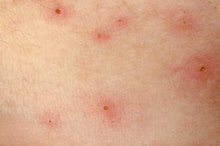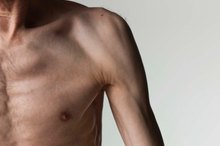What does fact checked mean?
At Healthfully, we strive to deliver objective content that is accurate and up-to-date. Our team periodically reviews articles in order to ensure content quality. The sources cited below consist of evidence from peer-reviewed journals, prominent medical organizations, academic associations, and government data.
The information contained on this site is for informational purposes only, and should not be used as a substitute for the advice of a professional health care provider. Please check with the appropriate physician regarding health questions and concerns. Although we strive to deliver accurate and up-to-date information, no guarantee to that effect is made.
What Causes Dark Spots on the Arms & Shoulders?
Your skin is the largest and most exposed organ of your entire body. As such, it is constantly bombarded both internally and externally by factors that can change its structure, texture and color. On the shoulders and arms, these can manifest through areas of hyperpigmentation that create dark spots. These spots can form for several reasons. It is important to remember to see your doctor about spots on your skin to ensure that they are not potentially harmful, such as with skin cancer.
Sun
Unprotected exposure to sunlight is one of the most common reasons spots can develop on your shoulders and arms. As you spend excess time in the sun, your skin becomes altered, causing the melanocytes of your skin tissues to create excess melanin. Melanin is the substance that gives your skin its color. This melanin can clump together, forming hyperpigmented areas of skin called sun spots. Although the spots themselves are not dangerous, sun spots can increase your risk of cancer or may be an early warning sign of skin cancer, states the National Institutes of Health's Medline Plus 1.
- Unprotected exposure to sunlight is one of the most common reasons spots can develop on your shoulders and arms.
- As you spend excess time in the sun, your skin becomes altered, causing the melanocytes of your skin tissues to create excess melanin.
Skin Injuries
What Are Raised Bumps on the Skin?
Learn More
Certain skin injuries can also alter your skin, creating spots on the shoulders and arms as a side effect called post-inflammatory hyperpigmentation 2. This side effect occurs when excess melanin is left over after the healing process of the skin, such as with a severe acne outbreak, or when old red blood cells die near the skin's surface, leaving an iron pigment behind. In addition to acne, other skin injuries that can cause spots include burns, scrapes, insect bites and cuts.
Medications
Certain medications can also cause spots to form on the skin, including on your shoulders and arms. For example, taking estrogen can increase the production of melanin, resulting in blotchy or hyperpigmented skin. Other medications that may cause skin spots as a side effect include the anti-epileptic drug phenytoin, the tranquilizer drugs known as phenothiazines and tetracycline antibiotics.
Disease
Bumps on the Skin on Your Shoulders
Learn More
Disease can also affect the pigmentation of your skin. One of the most prominent of these diseases is the skin cancer known as melanoma, which can develop due to sun damage on the skin. Other diseases and disorders that may cause dark spots include hemachromatosis, Riehl's melanosis, pituitary tumors, Addison's disease and eczema.
Related Articles
References
- National Institutes of Health: Sun Exposure
- Skin Sight: Post-Inflammatory Hyperpigmentation
- American Academy of Dermatology: Mature Skin
- Vashi NA, de Castro Maymone MB, Kundu RV. Aging differences in ethnic skin. J Clin Aesthet Dermatol. 2016;9(1):31-38.
- American Osteopathic College of Dermatology. Hyperpigmentation.
- Bandyopadhyay D. Topical treatment of melasma. Indian J Dermatol. 2009;54(4):303-309. doi:10.4103/0019-5154.57602
- Kang SJ, Choi BR, Lee EK, et al. Inhibitory effect of dried pomegranate concentration powder on melanogenesis in B16F10 melanoma cells; involvement of p38 and PKA signaling pathways. Int J Mol Sci. 2015;16(10):24219-42. doi:10.3390/ijms161024219
- Parveen R, Akhtar N, Mahmood T. Topical microemulsion containing Punica granatum extract: its control over skin erythema and melanin in healthy Asian subjects. Postepy Dermatol Alergol. 2014;31(6):351-5. doi:10.5114/pdia.2014.47117
- Kim E, Hwang K, Lee J, et al. Skin protective effect of epigallocatechin gallate. Int J Mol Sci. 2018;19(1). doi:10.3390/ijms19010173
- Kim YC, Choi SY, Park EY. Anti-melanogenic effects of black, green, and white tea extracts on immortalized melanocytes. J Vet Sci. 2015;16(2):135-43. doi:10.4142/jvs.2015.16.2.135
- Zhou BR, Ma LW, Liu J, et al. Corrigendum to "protective effects of soy oligopeptides in ultraviolet B-induced acute photodamage of human skin". Oxid Med Cell Longev. 2018;2018:3871280. doi:10.1155/2016/5846865
- Adhikari D, Panthi VK, Pangeni R, Kim HJ, Park JW. Preparation, characterization, and biological activities of topical anti-aging ingredients in a Citrus junos callus extract. Molecules. 2017;22(12). doi:10.3390/molecules22122198
Writer Bio
Chris Sherwood is a professional journalist who after years in the health administration field and writing health and wellness articles turned towards organic sustainable gardening and food education. He now owns and operates an organic-method small farm focusing his research and writing on both organic gardening methods and hydroponics.








